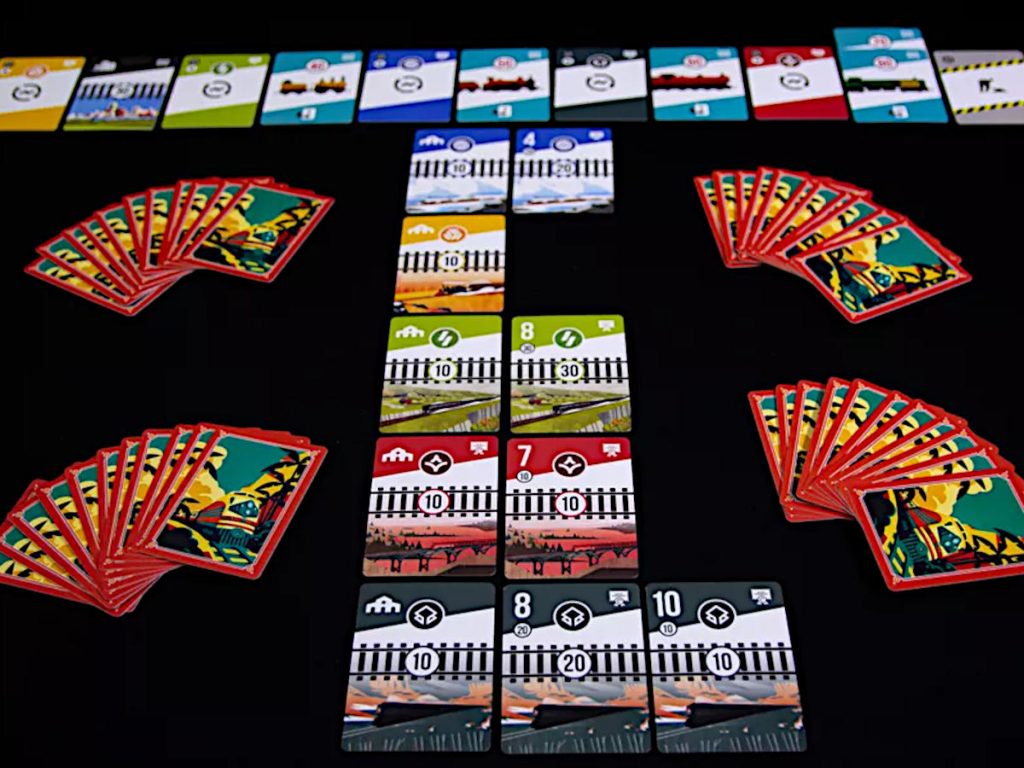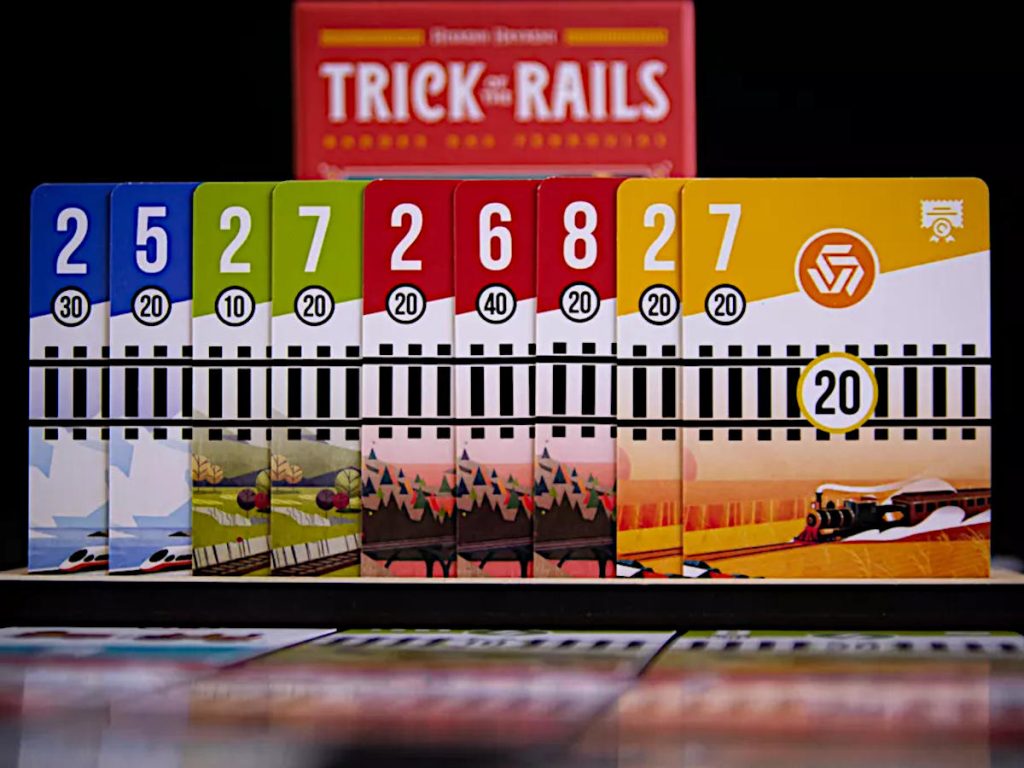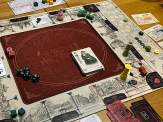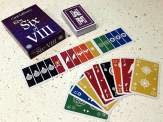| Release Date: 2011 | Players: 3-5 |
| Designer: Hisashi Hayashi | Length: 15-30 minutes |
| Artist: Ann-Sophie De Steu, Diego Sá | Age: 10+ |
| Publisher: Grok Games | Complexity: 3.0 / 5 |
| Plastic (by weight): unknown | Air (by volume): unknown |
It is the golden age of American railways. Rail stocks are all the rage, with new companies flooding the stock market all the time. The stakes are high, but you want to have a slice of the pie. The returns look great and investors get a say on a company’s track-laying. To make it big, you have to be clever and know the Trick of the Rails by Hisashi Hayashi from Grok Games with illustrations from Ann-Sophie De Steu and Diego Sá.
Listen to the Audio Version
Intro Music: Bomber (Sting) by Riot (https://www.
Sound Effects: bbc.co.uk – © copyright 2025 BBC
Our Quiet Company by Blue Dot Sessions
Well, well, well. So not only have I been lucky enough that my game group has been infected by my long-standing love of trick-taking games and that they are knee-deep in the heady heights of 18xx games, but now we have discovered a game that wonderfully combines these two amazing genres. However, let’s not get too far ahead of ourselves or we might miss the train completely.
Trick of the Rails is definitely a mostly traditional trick-taking game. There are suits and players have to follow suit, there are no trumps, the person winning a trick leads the next trick and so on. Yet, as steam engines did in their time, the game uses some really clever engineering to make it feel like an 18xx game. As you play your tricks, you earn shares, lay track and buy locomotives, there are town and city stops and right at the end, you even run your trains to score points. It’s unbelievable, but it really works, and playing the game is as exciting as sticking your head out of a carriage window in a train that is speeding along at dozens of miles an hour.

18xx Tricks
The way Trick of the Rails achieves this is pretty simple, but very clever. The five suits represent different train companies, with cards in each suit numbered 1 to 10. Each card also shows a piece of track and a stop worth a certain number of dollars. The distribution of these varies between suits, creating a bit of asymmetry. Each company also starts with a section of track, represented by a certain number of cards randomly drawn from the deck at the beginning of the game. That sets the scene and allows players to make a rough plan of what companies they would like to invest in.

Get yourself a wooden Tabletop Games Blog dice tray.
Each tray is the perfect size to roll your dice, and with the soft mat, it’s really quiet, while the wooden frame makes it wonderfully sturdy.
The problem is, you can’t just buy the shares you want. Instead, you’re playing tricks in the usual way. The lead player plays a card and everyone else has to follow suit. If they can’t, they can play a different card, but they won’t be able to win the trick. Where it gets clever is what happens to the cards in the trick. That’s where the 18xx magic happens.
There are a number of others cards laid out to one side that create the so-called trick lane. These cards either represent a share, a piece of track or a locomotive. The winner of the trick takes the first card of the trick lane and either adds it to their pile of shares, adds it to the existing track of the company matching the card’s colour or places the locomotive next to a company’s track, depending on what the first trick lane card is. The winning card is then similarly added to the player’s shares or as track. The remaining players then take their losing cards and either keep them as a share or add them as track in the same way.
Shares, Tracks and Locomotives
It may sound complicated, but the basic principle is that if you want to win the card in the trick lane, then you need to win the trick. If you’d rather keep the card you played, then you need to lose the trick. For example, if the first card in the trick lane is a yellow share and you want to get in on the yellow company, then you need to win the trick. You can win the trick with a blue card, if you want, because you don’t really care what card you win with. You want the yellow share from the trick lane.
The problem is, you need to pace yourself. Just like for real train companies, timing in Trick of the Rails is everything. You need to decide whether you wait for cards later in the trick lane or whether you pounce on a card now. Also, just winning shares of a specific company is useless if that company’s track is very short or not very lucrative or gets a locomotive that can only stop at two stops, for example. You need to make sure you win tricks so that you can not only invest in the best company, but also extend that company’s track and give it the diesel locomotive it so desperately deserves.
That’s what makes Trick of the Rails feel so very much like an 18xx game. Just because you invested heavily in one company and build a long route for it, without a good locomotive all of your hard work is in vain. You can easily run out of steam and leave most of your track empty.

Tricking the Rails
Of course, like in any other trick-taking game, you need to know how to use your hand to its best effect. Even a seemingly bad hand can be useful, if you know what to do. If you’re an experienced trick-taking player, you can use all of your experience in Trick of the Rails too. You can try and tease out high cards from other players, so that you can guarantee you will win the trick that you need at a time when you need it.
Also, the stop values printed on the cards matter. Some suits have high-value cards that will guarantee you win the trick, but the stop value is low, so adding it to that company isn’t actually that useful. That’s the element that means people who are still a bit new to trick-taking can still compete on an even level and stay on track. As I said, you have to consider what cards you have in your hand and use them in the right way to come out victorious in the end.
Trick of the Rails is a really fascinating game. If you ever have a hankering for an 18xx game, but don’t have the time, then breaking out this wonderful trick-taker is a good option. I was going to say that it’d be a good compromise, but to be honest, it doesn’t feel like you’re compromising when playing the game. It really does feel like you’re playing an 18xx game, even if there are no hex tiles or maps involved. Everything else is there. So, if you ask me, I’d say, get yourself a copy and then it’s full steam ahead.
If you enjoyed this article, please have a look at my support page to see how you can help keep the blog going.
Useful Links
- Trick of the Rails: https://travel-games.
co. uk/ shop/ p/ trick-of-the-rails - Rulebook: https://boardgamegeek.
com/ filepage/ 132844/ trick-of-the-rails-official-second-edition-rules - Grok Games: https://grokgames.
com. br/ - BGG listing: https://boardgamegeek.
com/ boardgame/ 118497/ trick-of-the-rails
Videos
Transparency Facts
I feel that this review reflects my own, independent and honest opinion, but the facts below allow you to decide whether you think that I was influenced in any way. Please also read my Ethics Statement for more information.- I was given a free review copy of this game by the publisher.
- At the time of writing, I have not received financial support from the publisher or anyone working on their behalf.
Audio Version
Intro Music: Bomber (Sting) by Riot (https://www.
Sound Effects: bbc.co.uk – © copyright 2025 BBC
Our Quiet Company by Blue Dot Sessions
Playlist
These are the songs I listened to while I was writing this review:





